SPECworkstation 3.0.2 Storage Benchmark
SPECworstation benchmark is an excellent benchmark to test systems using workstation-type workloads. In this test, we only ran the Storage component, which is fifteen separate tests.
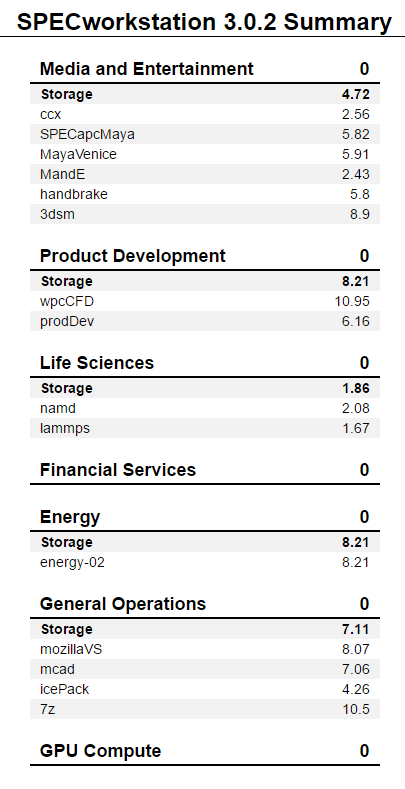
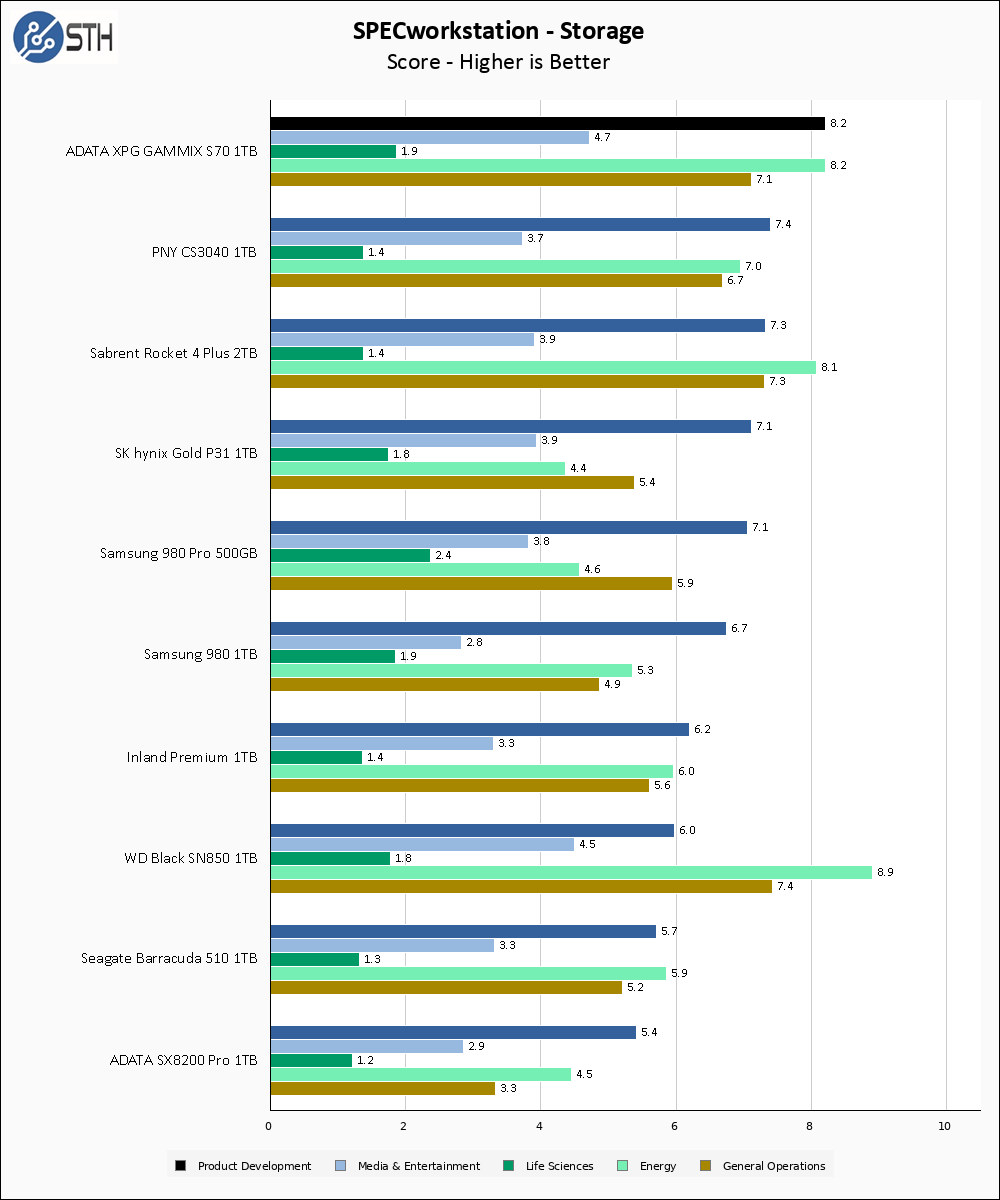
SPECworkstation has the ADATA XPG Gammix S70 1TB returning to the top of the chart, turning in some of the highest non-Optane results we have ever received.
Firmware problems, and a fix!
In the introductory paragraph, I hinted at the growing pains this controller and drive might experience, but up until this point, there has been no further reference to that. When I first received my XPG Gammix S70 1TB, directly purchased from Amazon, and ran benchmarks on the drive I was initially unimpressed with the drive. Performance seemed very inconsistent and much slower than the results being achieved by other reviewers who tested the drive. After some minor troubleshooting, I determined that the low performance was a result of testing with the drive more than half full – 67% full specifically for this drive – and that other reviewers did not load their drives as heavily. When I tested the drive in mostly-empty state, benchmarks were very impressive and in line with what other reviewers got.
I reached out to ADATA about my results, inquiring if this was a known issue, and I was provided firmware version 3.2.9.1 to flash on my drive. According to my contact, version 3.2.9.1 “optimized the speed of the capacity above 50%” and if you have read my review thus far you will know that the update was very effective. 3.2.9.1 is the firmware level used for all of the results you see in today’s review, but I did want to showcase the vast difference the new firmware made, as well as advocate that you update your drive if you are running the older firmware.
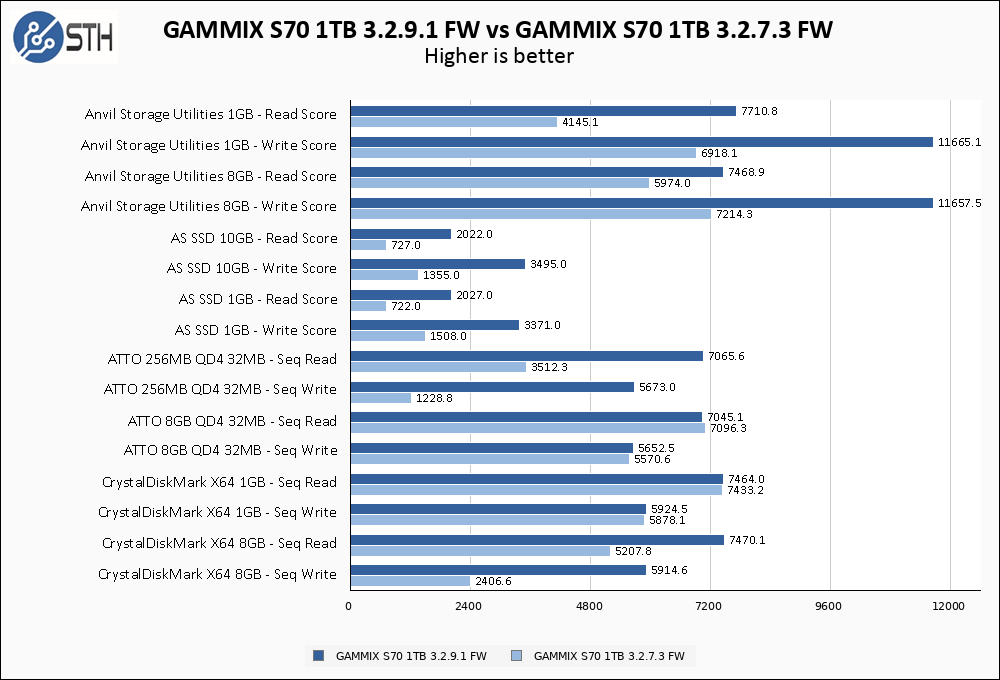
My drive originally arrived with firmware 3.2.7.3 onboard, and as you can see from the comparison the results were significantly worse almost across the board. My guess is that this has to do with the newness of the InnoGrit controller and working out some of the firmware kinks. This poor performance only existed while the drive was loaded up with data; fresh out of the box its performance was very good and did not have any problems.
In any case, I wanted to draw attention to the potential issue for the owners of the S70. Unfortunately, while the firmware process itself is quick and easy it does result in wiping the clearing the data from the drive, so you will want to take necessary precautions and back up your system prior to the update.
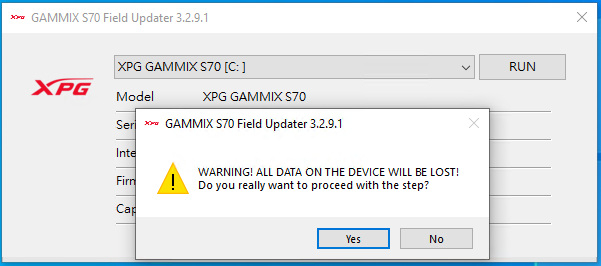
The download is available here, and if you already have a S70 I highly recommend updating!
Sustained Write Performance
This is not necessarily a benchmark, so much as trying to catch the post-cache write speed of the drive. While I am filling the drive with data to the 85% mark with 10 simultaneous write threads, I monitor the drive for the write performance to dip to the lowest steady point and grab a screenshot.
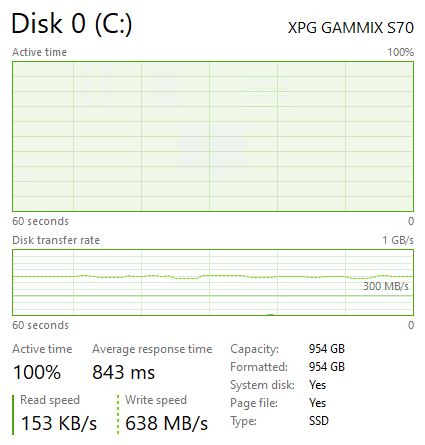
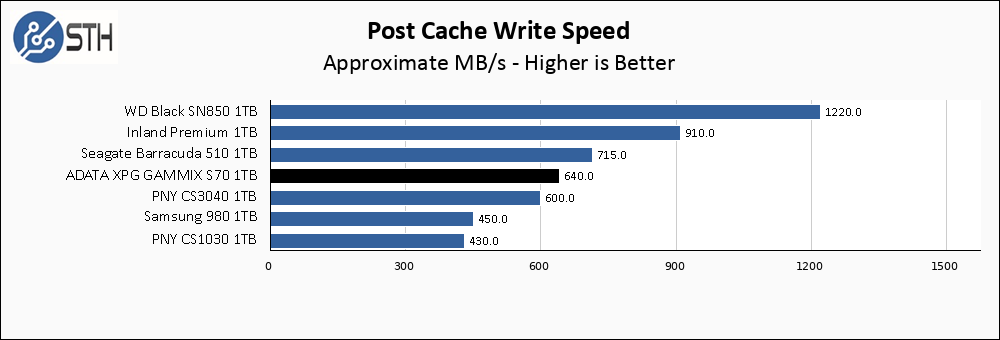
Sustained write performance is fine on the S70. For about half the drive, write performance remained above 1 GB/s, but it fell to 640 MB/s territory after that point. This number is not class-leading, but it is not terrible either.
Temperatures
We monitored the idle and maximum temperature during testing with HWMonitor to get some idea of the thermal performance and requirements of the drive. Please keep in mind that our test bench is an open frame chassis in a 22C room, but with no direct airflow. As a result, this is not representative of a cramped low airflow case and is instead intended to model temperatures of a drive ‘on its own’.

Well, I am certainly glad the ADATA XPG Gammix S70 1TB comes with a built-in heatsink. Topping out at 68C keeps the S70 just on the right side of the troublesome 70C mark, and it is all thanks to the heatsink.
Again, we are mostly looking for the absence of runaway thermals here during our testing rather than comparing drives to each other.
Final Words
The ADATA XPG Gammix S70 1TB SSD is $160 on Amazon right now. By comparison, the WD SN850 1TB with heatsink is $250, while the Sabrent Rocket 4 Plus and Samsung 980 Pro 1TB are both $200. The S70 represents a thoroughly competent competitor to all of those drives at a significantly discounted price point, making the value proposition of the S70 spectacularly good.
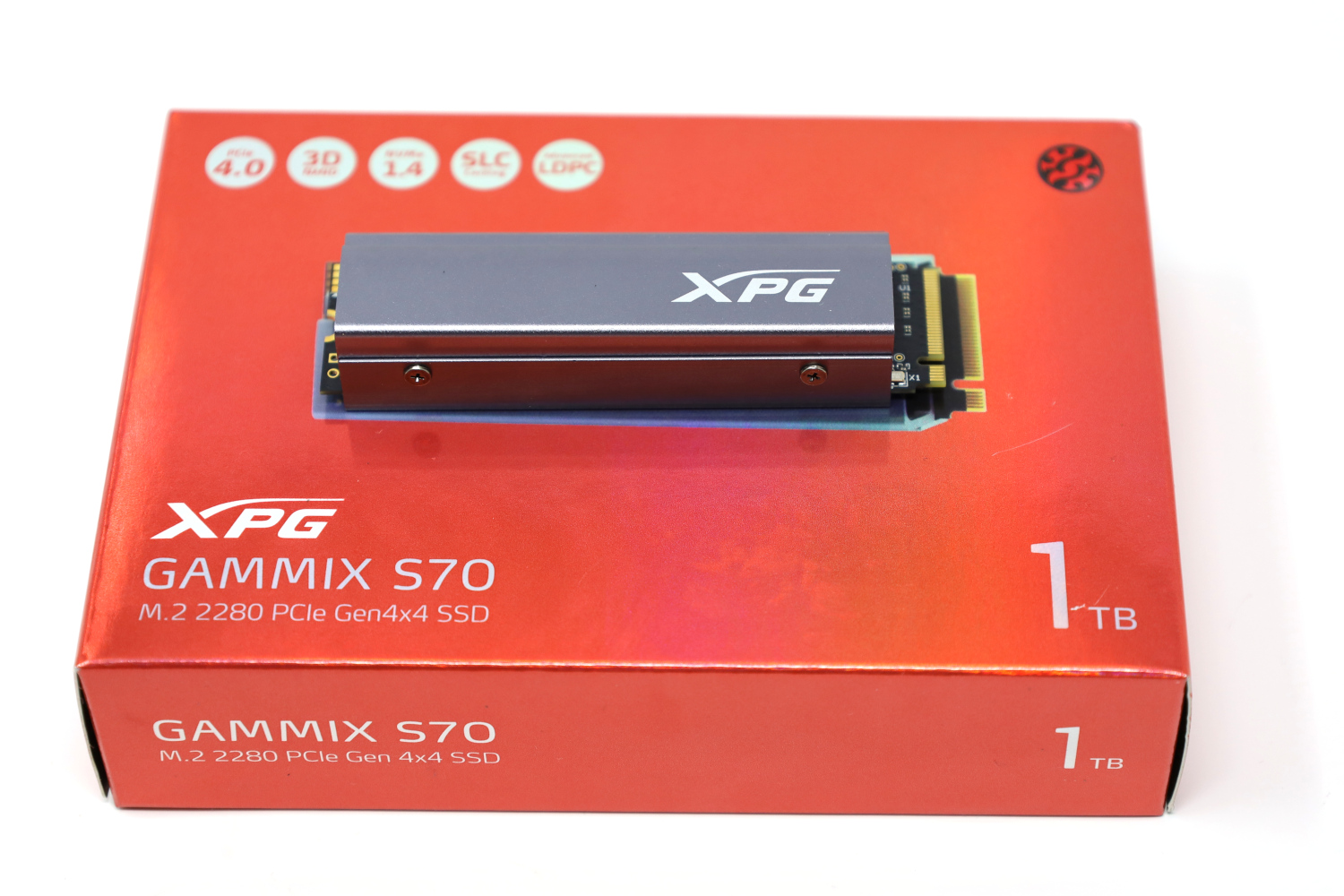
Unless the unremovable heatsink would prevent you from using this drive, the ADATA XPG Gammix S70 should absolutely be on your radar if you need a high-performance PCIe 4.0 NVMe SSD. Additionally, I will need to keep an eye out for other drives based on the Innogrit controller since it turned in such an impressive showing here. The XPG Gammix S70 1TB is the best price to performance PCIe 4.0 SSD I have seen, and buyers should be very happy with it.




SSD with a non removable heatsink from a company infamous for switching controllers and NAND is going to be a hard pass. Wouldn’t put it past them to send high performing cherry picked models to reviewers and down the line shafting consumers with more inferior variants.
David,
ADATA did not provide this SSD, it was purchased at retail.
Hi Will, thanks for this review. I had one of these. The m.2 slot on my board was located between PCIe slot 1 and the CPU, so not the worst airflow in the case. Still I had to set a 40mm fan to blow air over it, nvme tool reported it hitting 70C when in heavy read use. These things run insanely hot. The performance was very good though and the price was good.
My understanding is 5500MB/s translates to 740TB every 37.4 hours. When a vendor makes a particularly high claim for drive endurance, is this only for the warranty, or does the drive really handle that write load?
In the name of trust but verify, I think it would be useful as a test to spend the total endurance rating, set the drive on the shelf for a week and then check if all the data is still there from the last write.
Eric,
If you write continuously to the drive, write speed drops to 640 MB/s or so as shown in my testing. At that rate, it would take 14 days of continuous writing just to reach the rated 740 TB endurance rating, which is impractical for my review purposes.
With that said, endurance rating primarily serves as a warranty device. It’s like a car mileage warranty – 10 years or 100000 miles whichever comes first. Your SSD is the same, 5 years or 740TB whichever comes first.
“Samsung Rocket 4 Plus” you say? I want one!
@Will – i’m a bit with David on this one. Not that you shouldn’t test it, but Adata has been caught redhanded with altering production to inferior components after the first batches and NOT altering SKU’s or anything else. As shown by Linus Tech Tips who got hold of a whole bunch of them from different batches.
So although the performance is great on this particular unit (i have a gammix unit myself and one of the SX8200 pro’s from the older batches) There is unfortunately no possible way to be certain that during production lifetime, this will hold up. Unless Adata becomes a lot more transperant on why they did this and shows some commitment that they won’t do it again. So the article should be taken with the precaution that that was the initial stage, and there may be problems down the road.)
Claus,
I’m fully aware that ADATA has swapped components on their drives in the past; I was one of the first reviewers to take note of a component swap (the controller) back when I reviewed the SX8200 Pro.
With that said, while I generally disagree with the idea of swapping components without releasing a new SKU, for ADATA at least they do not seem to be cherry picking nor front-loading their drives that they send to reviewers; the SX8200 Pro I reviewed and noted had an inferior controller was provided by ADATA themselves. In addition, nowhere in any of their marketing materials do they guarantee a specific controller or NAND; instead they guarantee a performance rating (so many MB/s). Basically they set their own bar fairly low, so they can easily pass it.
I’m not saying it excuses the behavior; I would still much prefer drives with different components have different SKUs. However, for me all of that moves the dial when it comes to whether I assign a malicious or deceptive motivation to the practice. If ADATA had sent me one of the highest performance variants of the 8200 Pro, or dodged my question when I pointed out the controller change, then my attitude towards them would be very different.
I have an s70 1tb I just purchased from B&H with the latest firmware revision. My CrystalDiskMark scores are closer to 5600/3800, and my ATTO scores are closer to 6.1/3.6. That’s a massive discrepancy from your numbers and what the drive is advertised to be able to do, and I didn’t realize they’d been caught with a bait and switch till after I purchsed and started trying to troubleshoot why my drive performance was so bad. Now, I’m still troubleshooting, but I’m pretty sure I’m going to have to return this drive because it’s essentially faulty since the reason I bought it was for the performance. The controller on mine is Inogrit Rainier 5236CAA, supposedly a fine controller, but the DRAM looks generic af, as does the actual NAND, which has little to no discernable labeling on it. This suggests that I’ve been screwed by ADATA, like thousands of other people.
So, should I buy one or not? If it’s a numbers game, and I have to play if I buy from Adata, what are the chances of getting what I think I’m paying for? Was this just a bad decision by some bureaucrat who’s since been fired or do they really not care if people take them seriously or not?